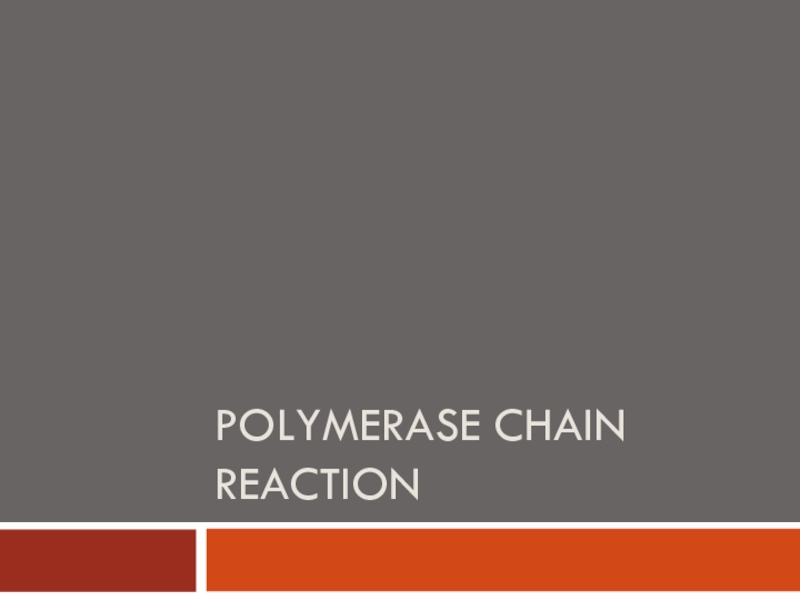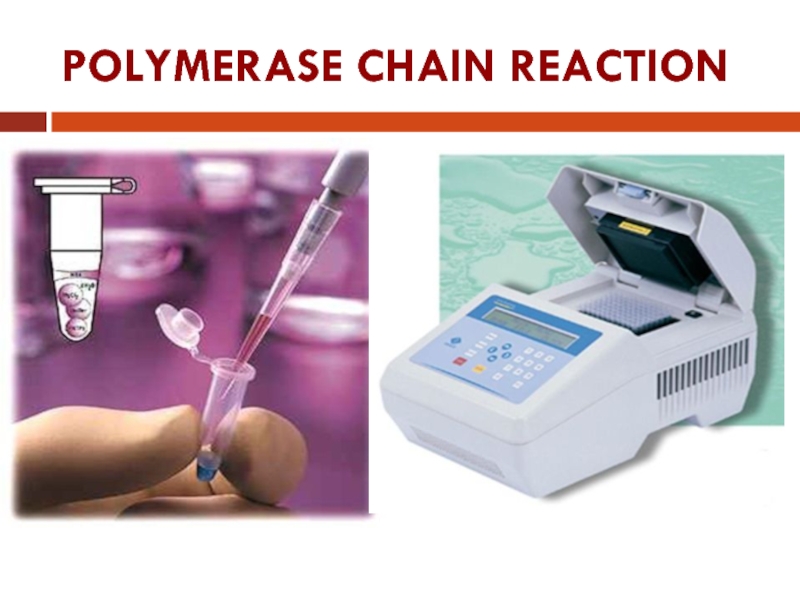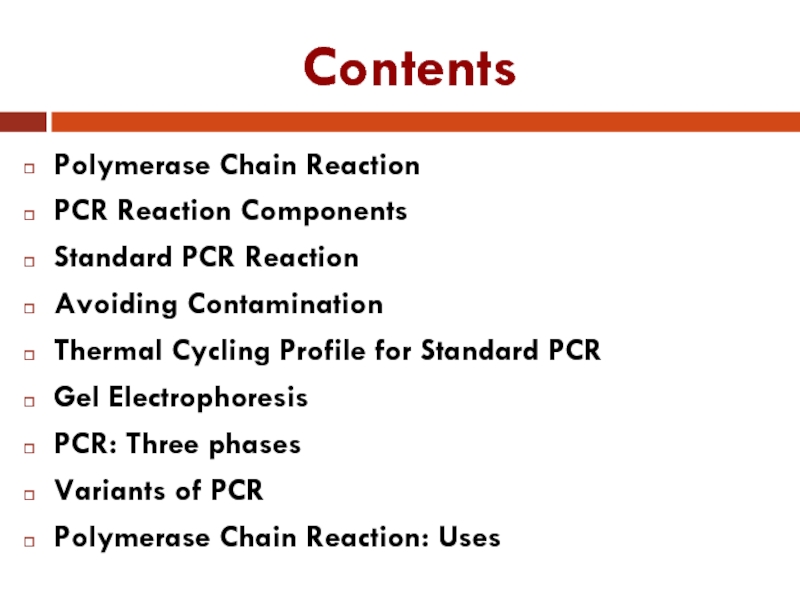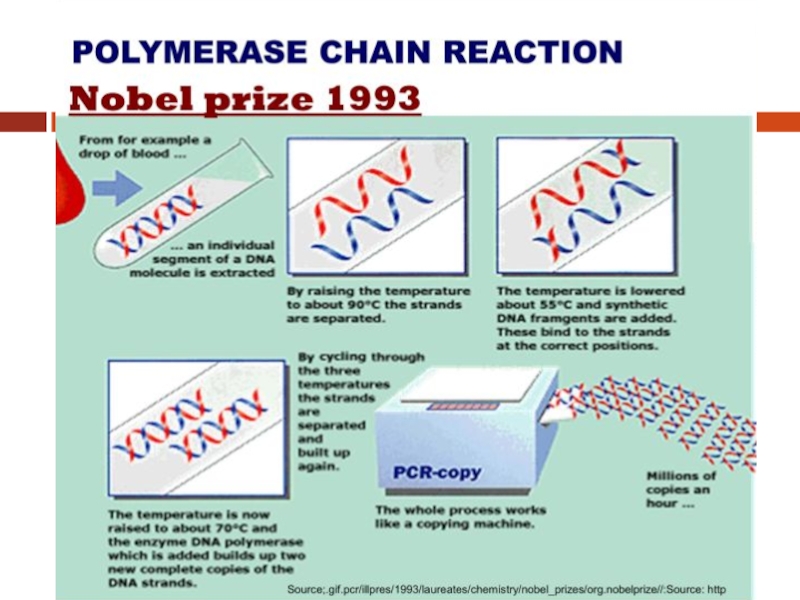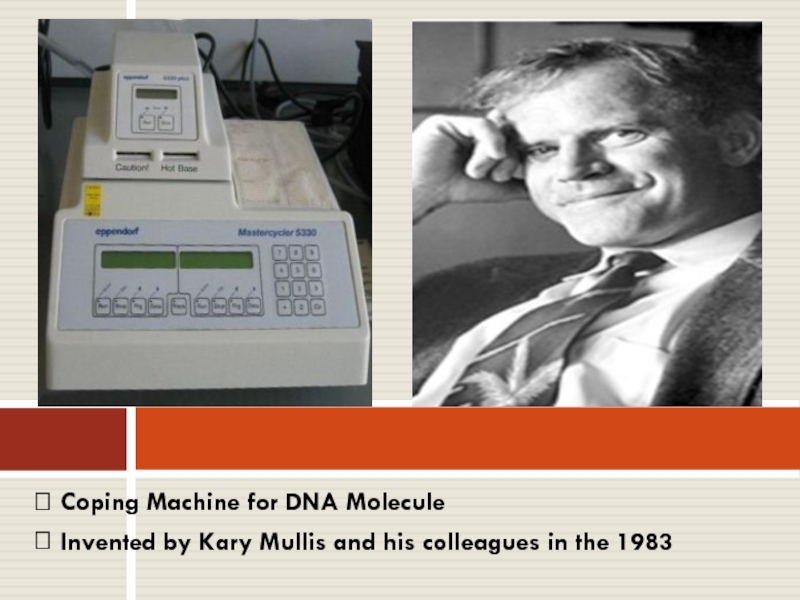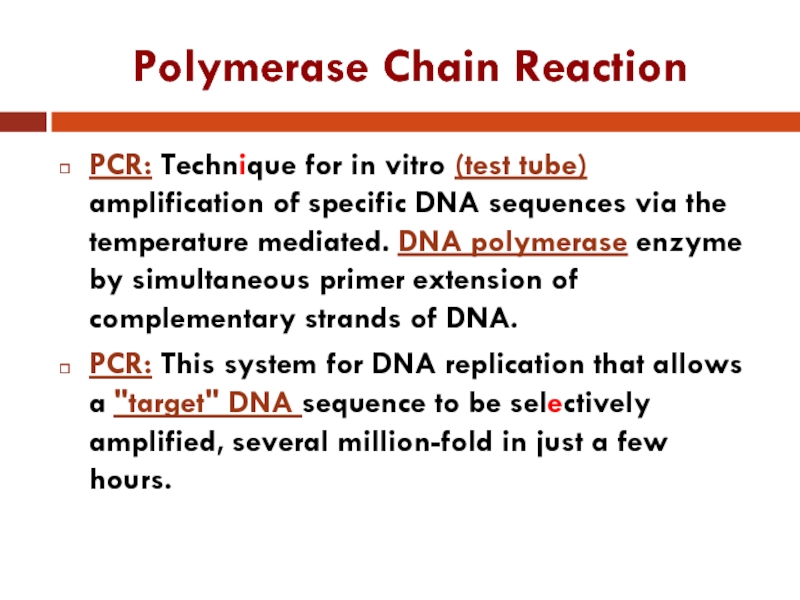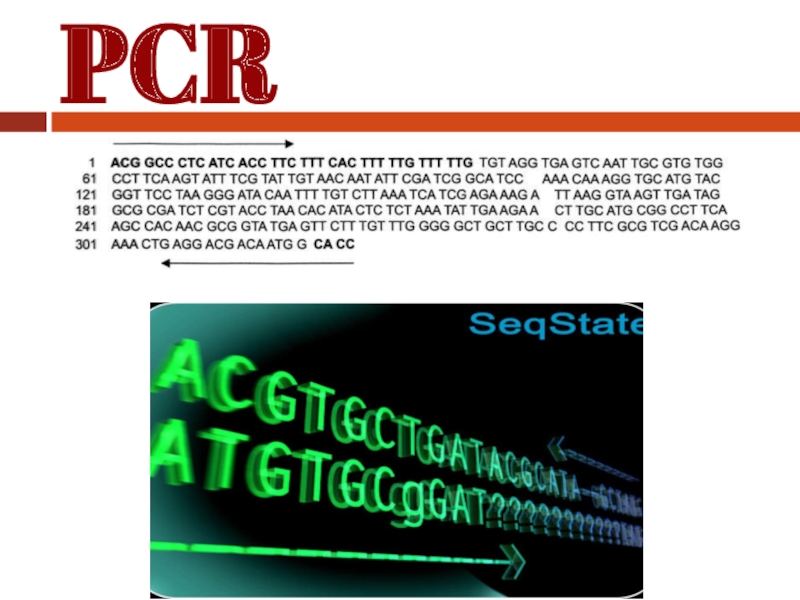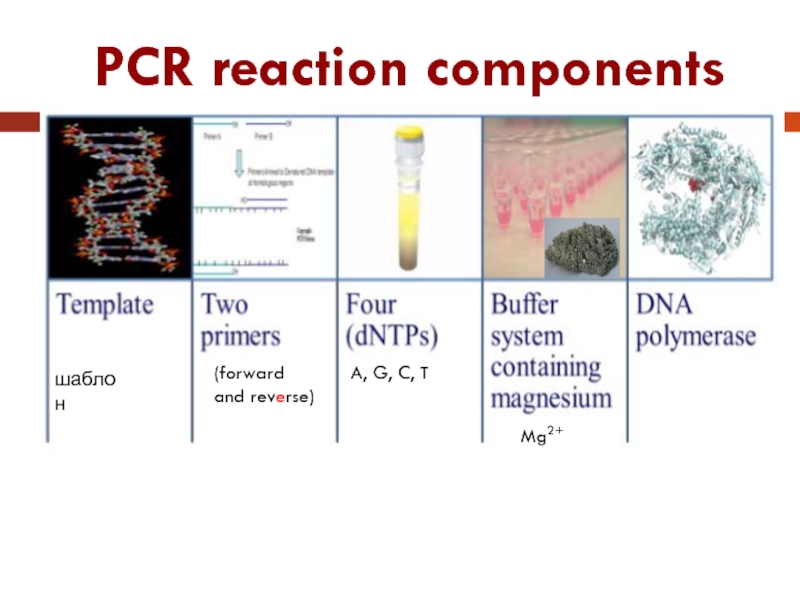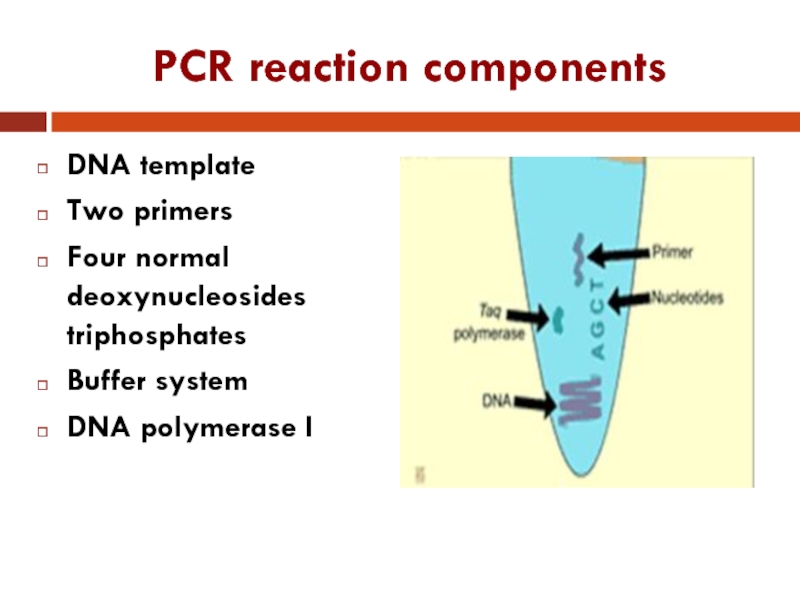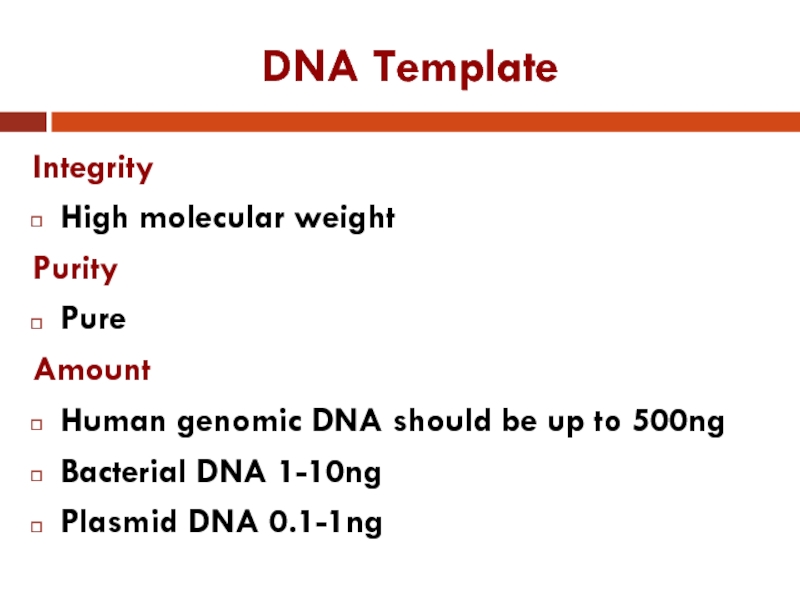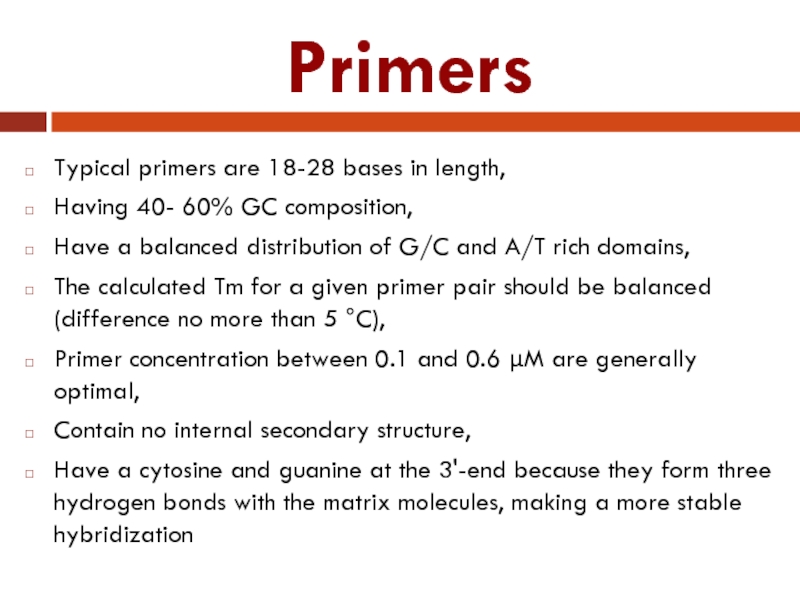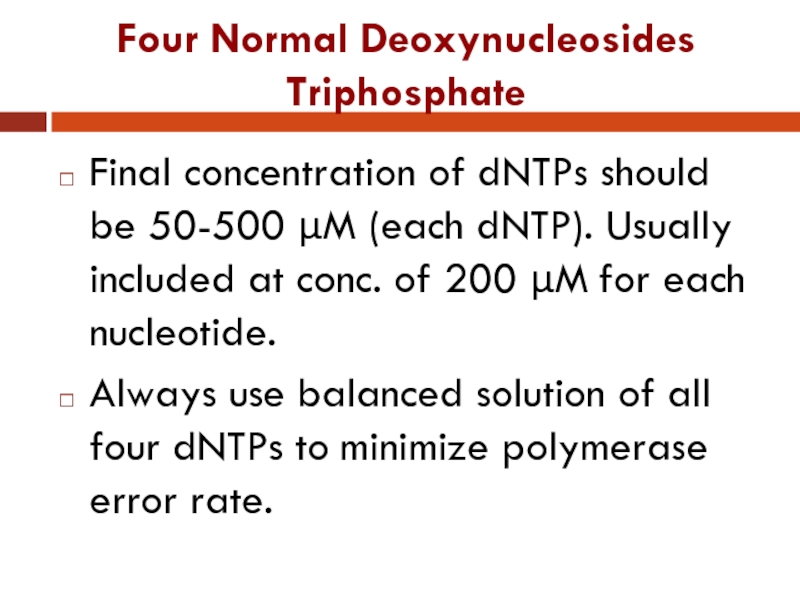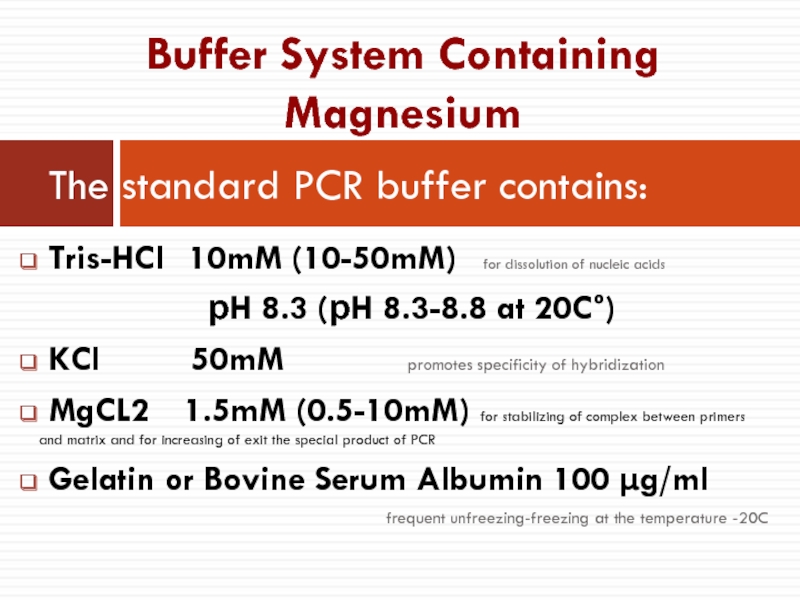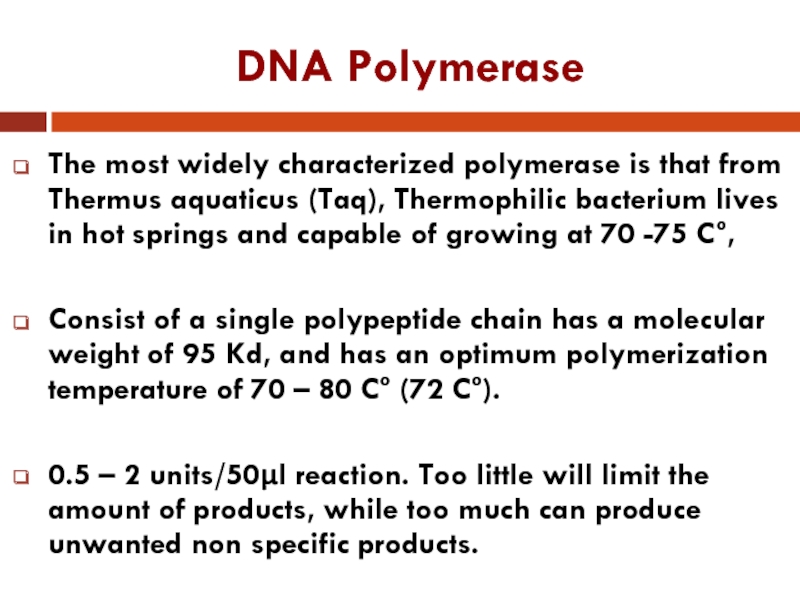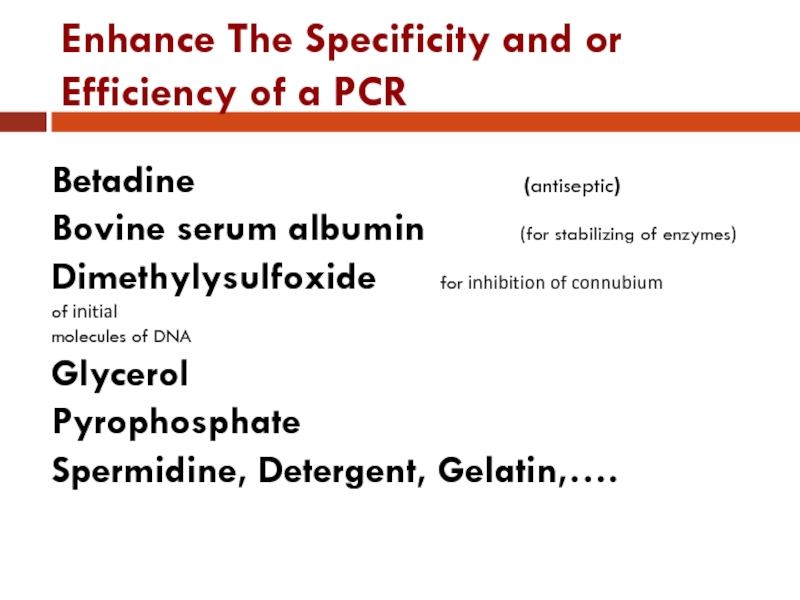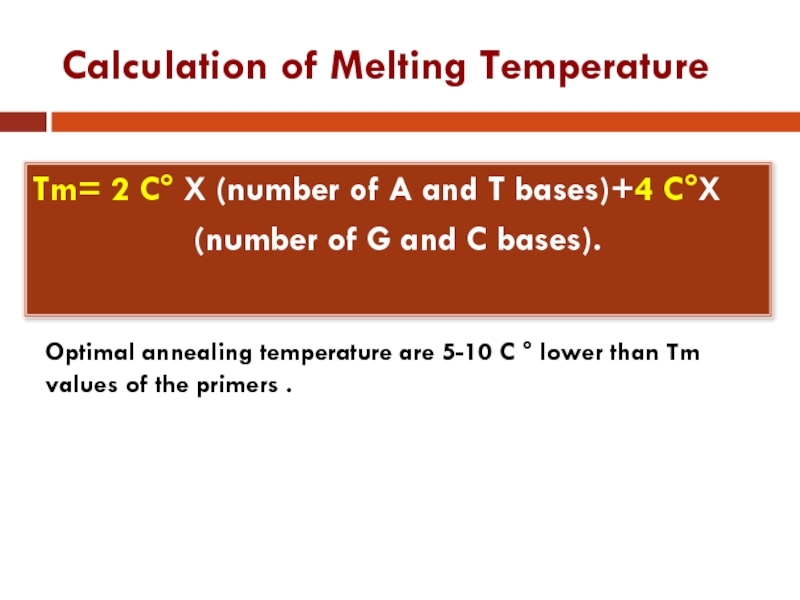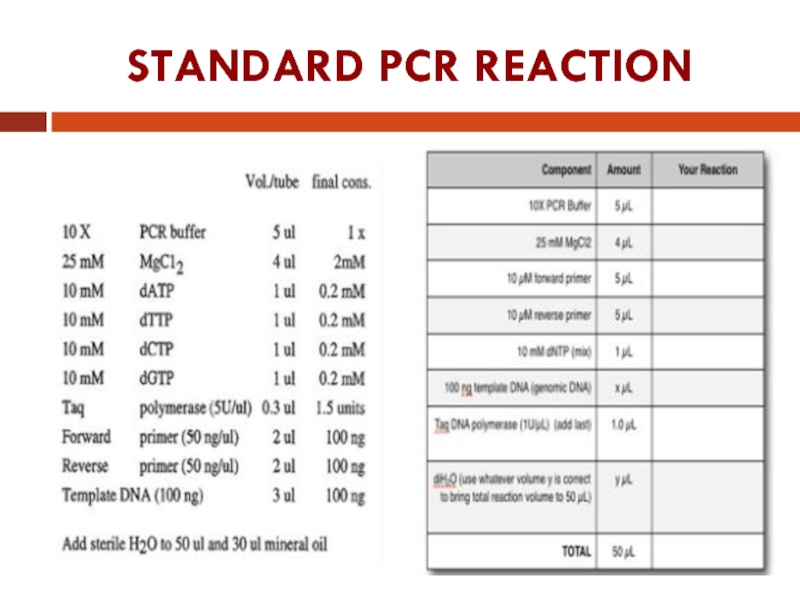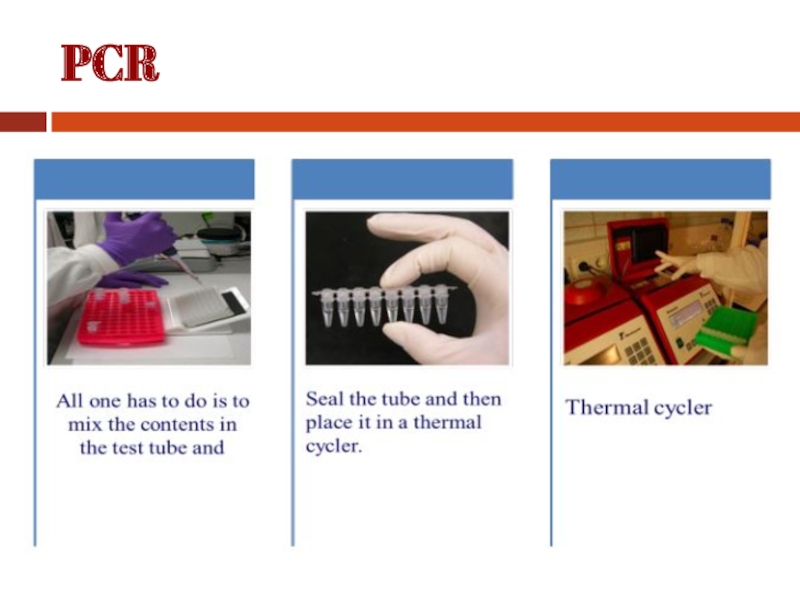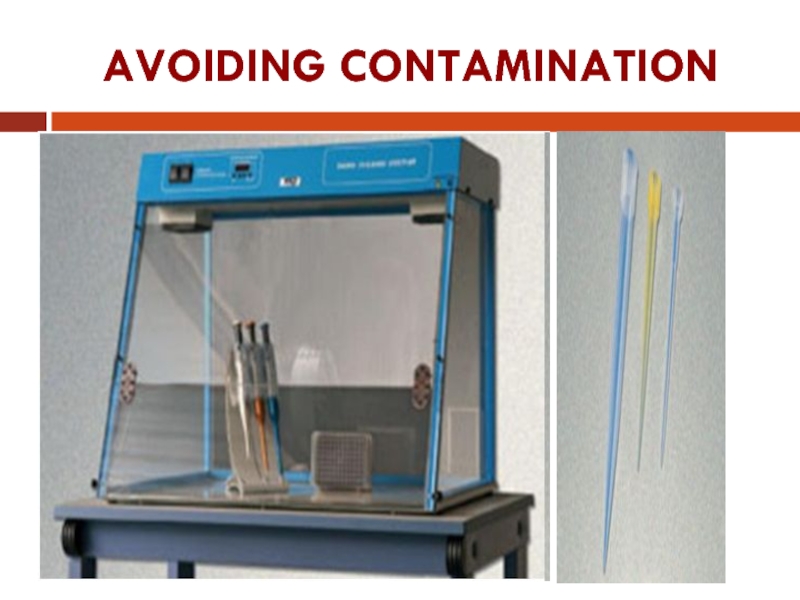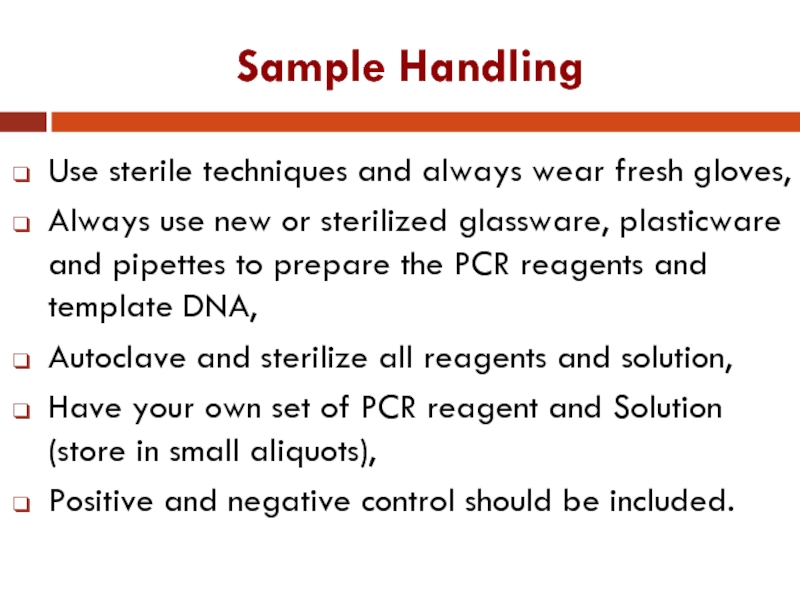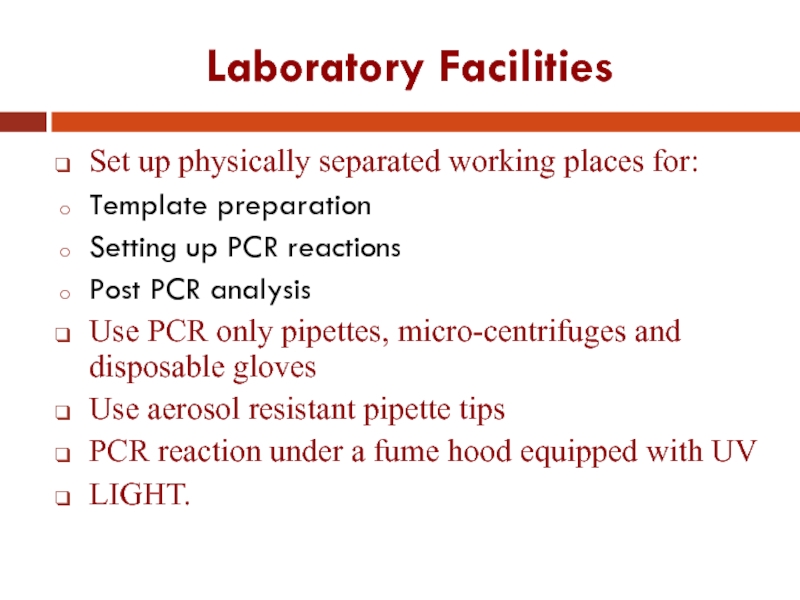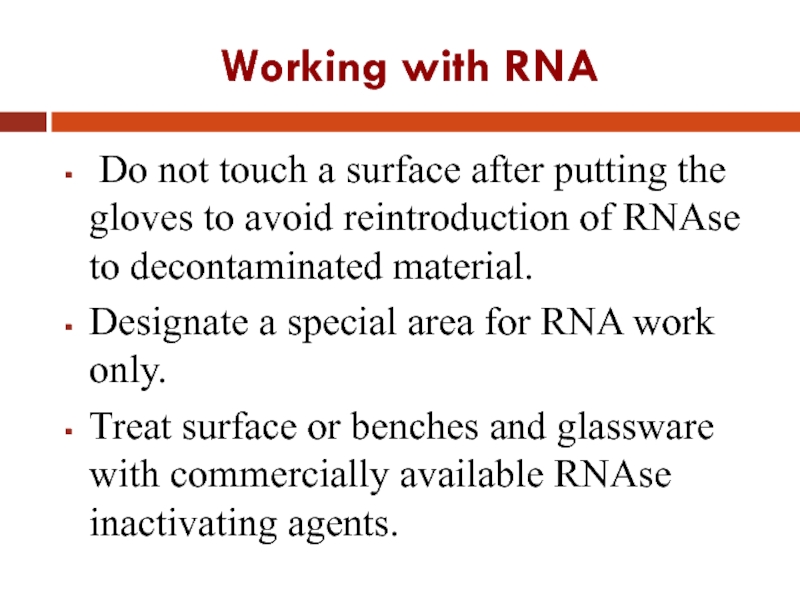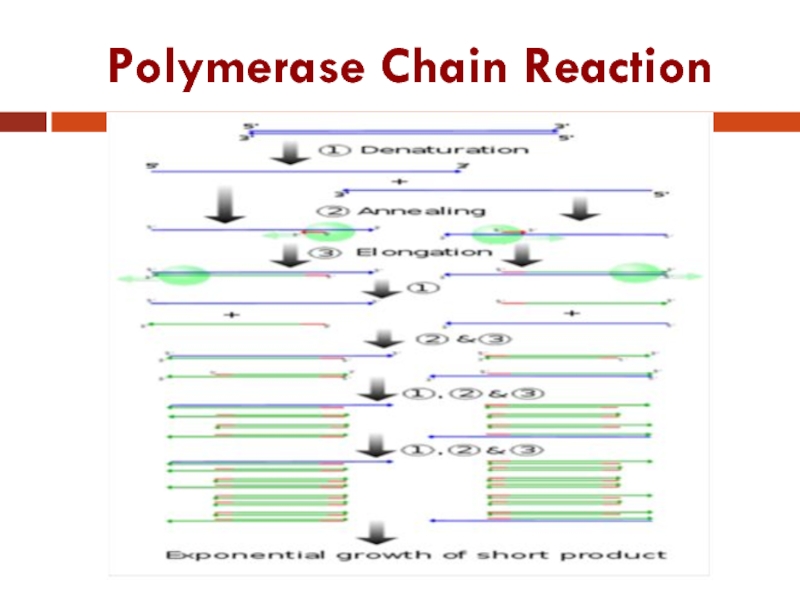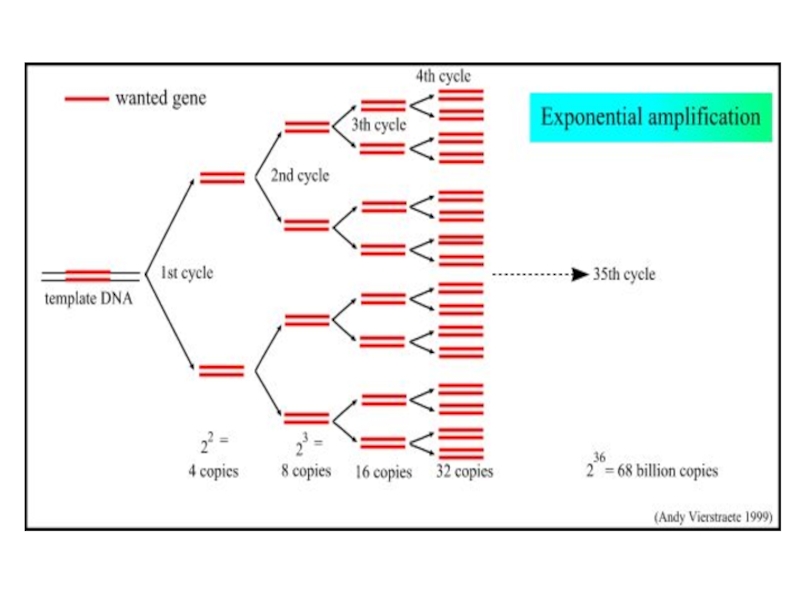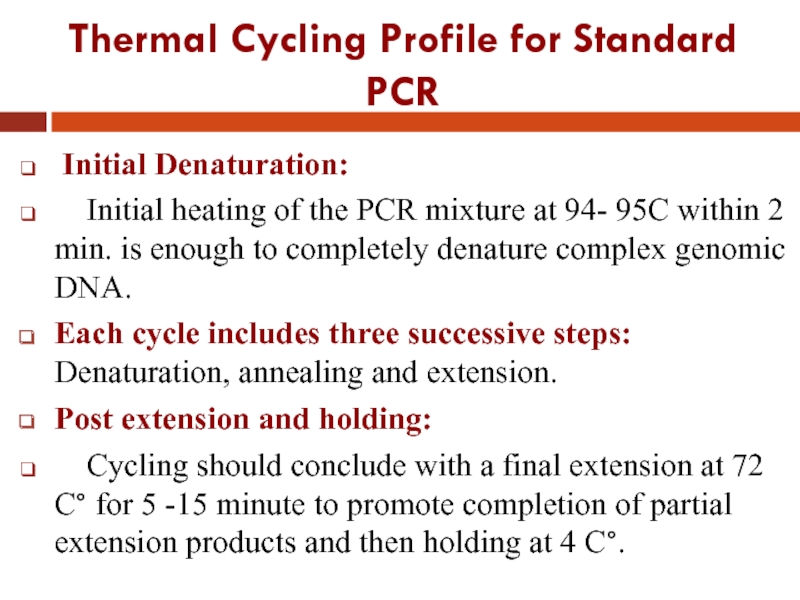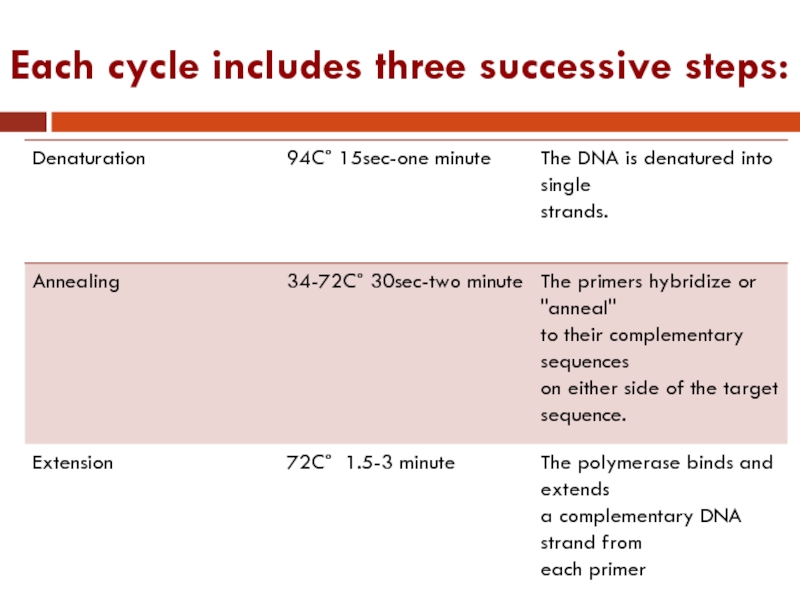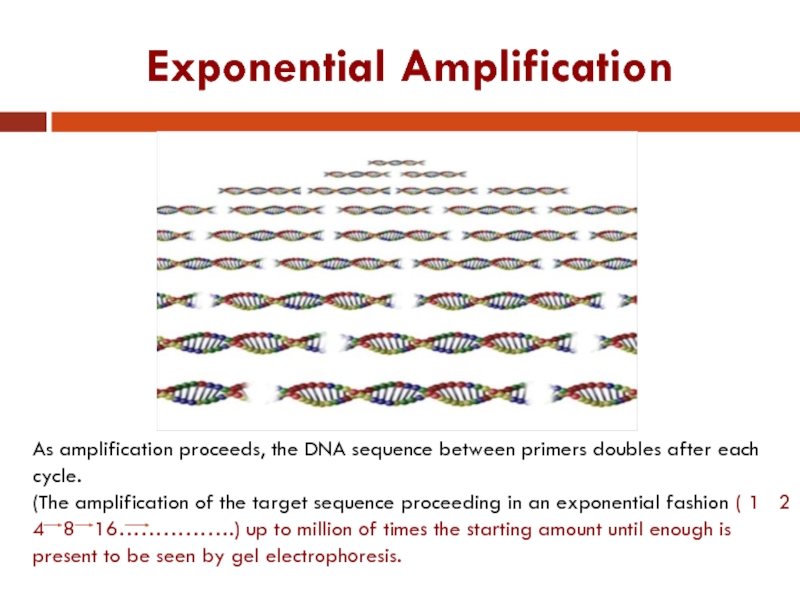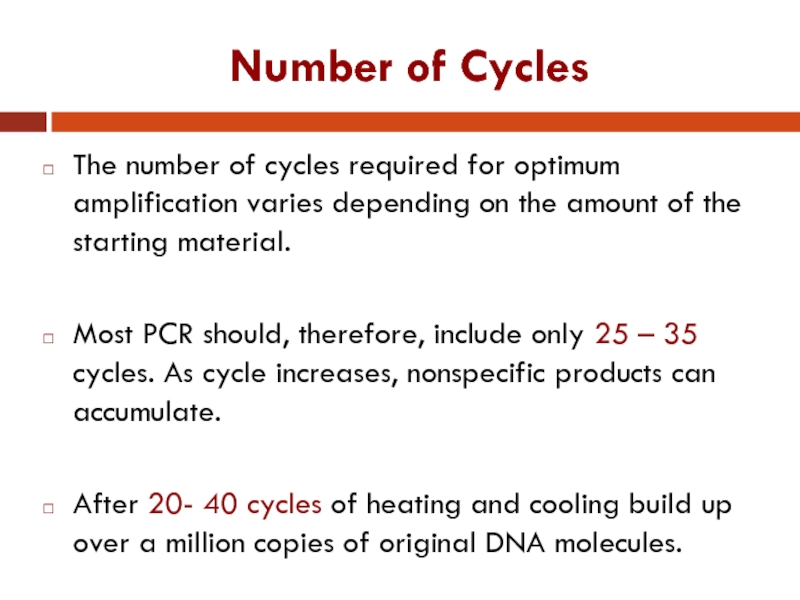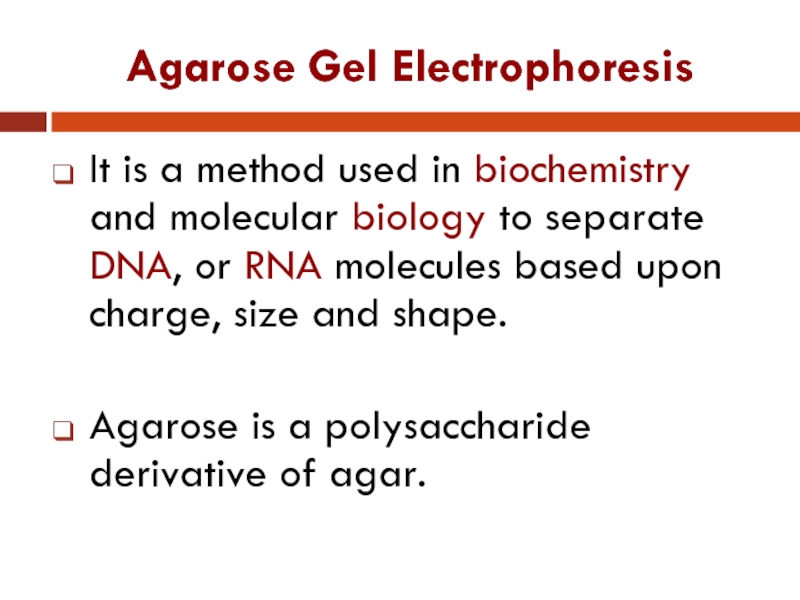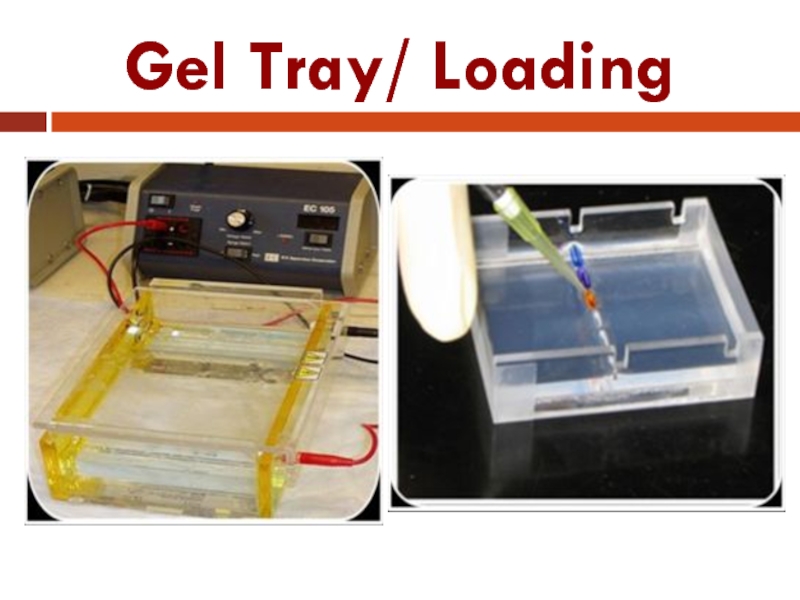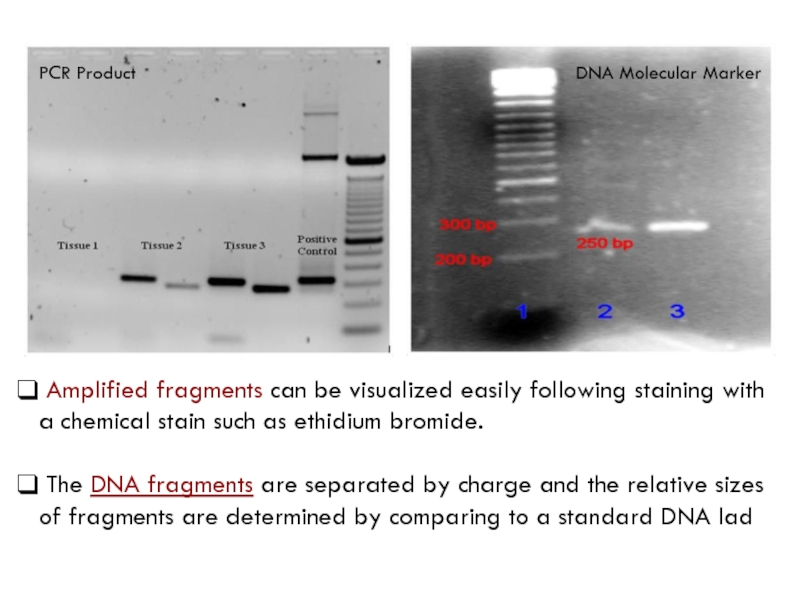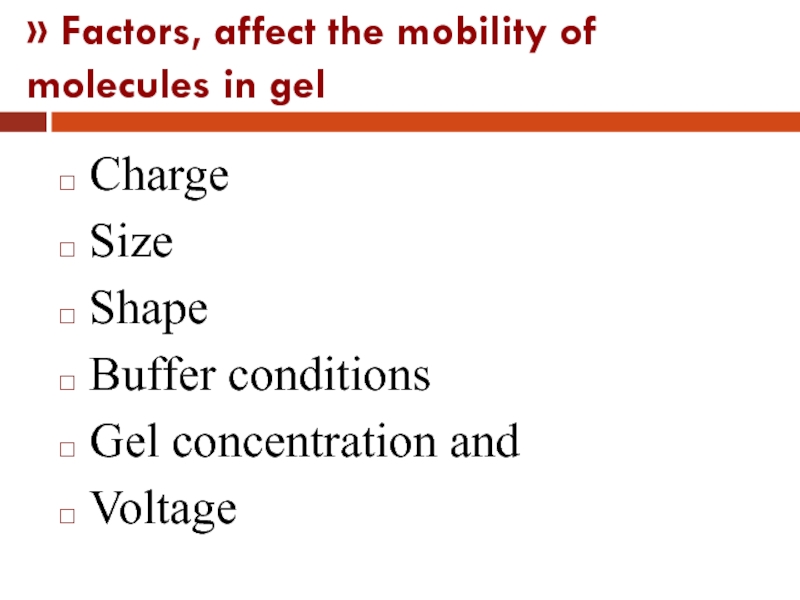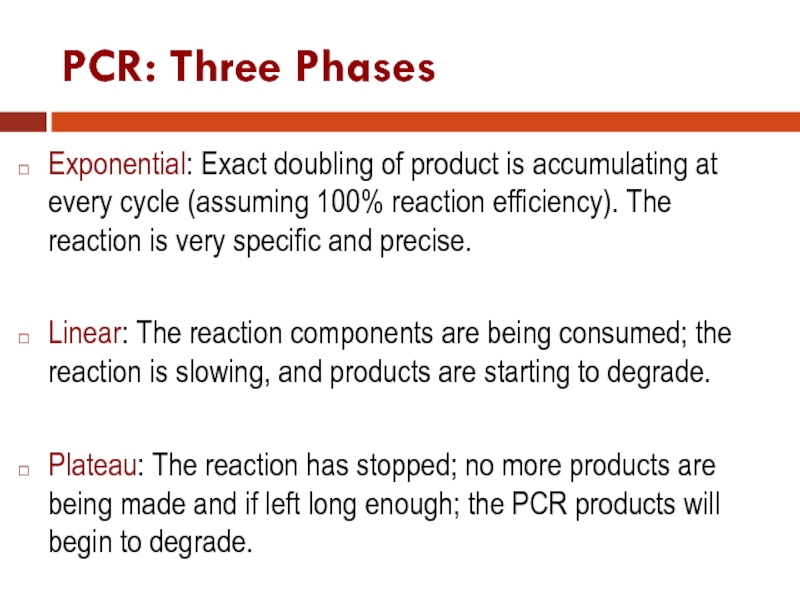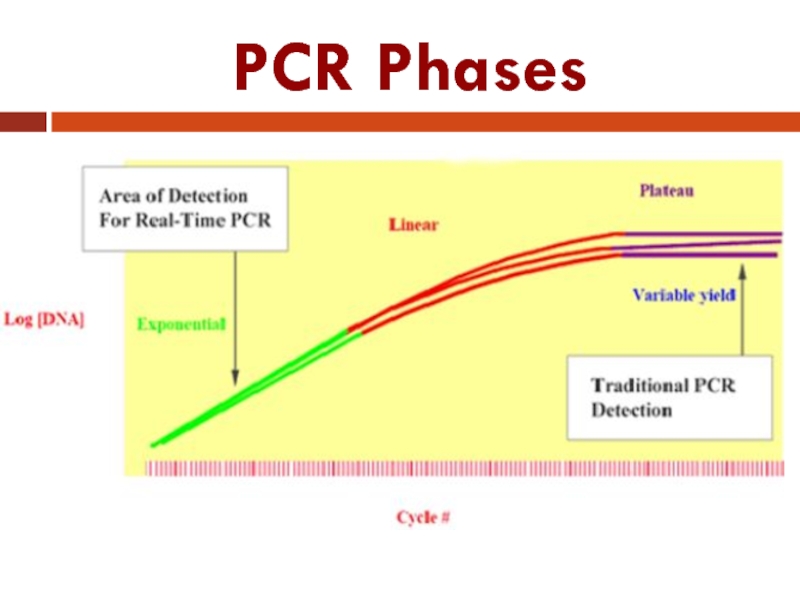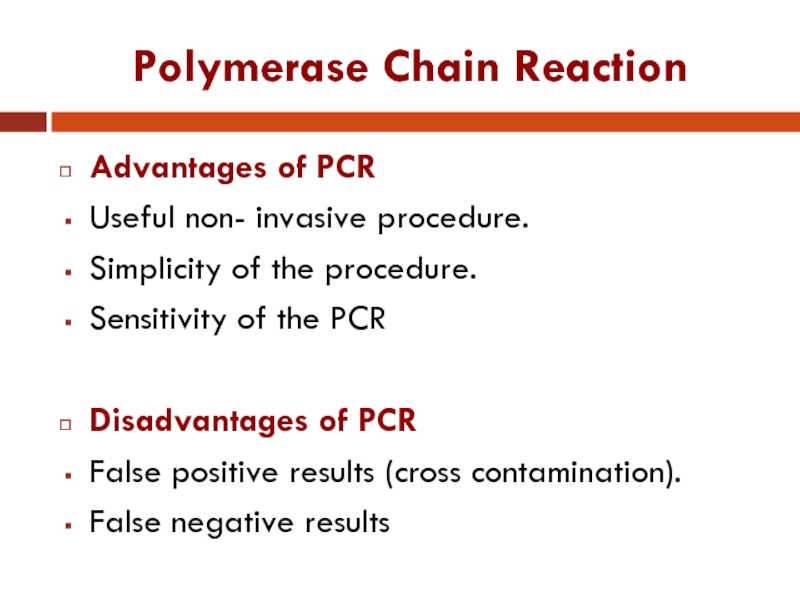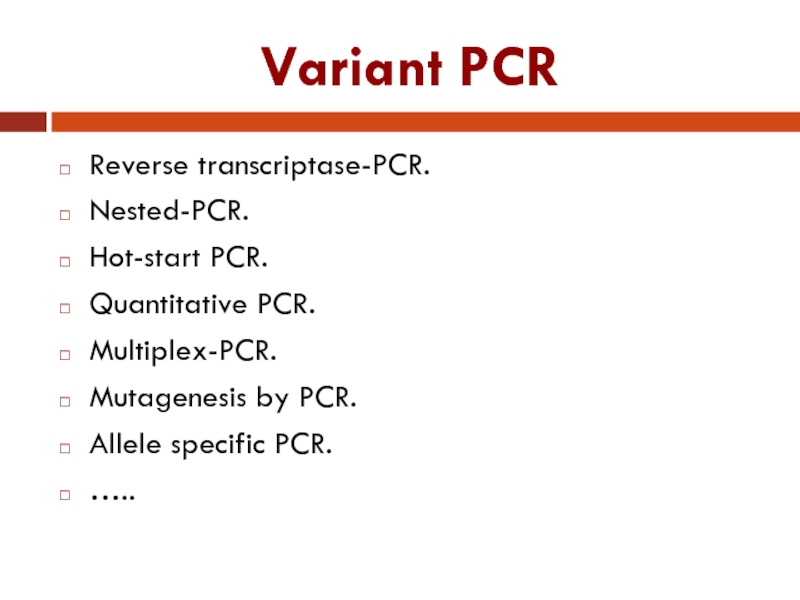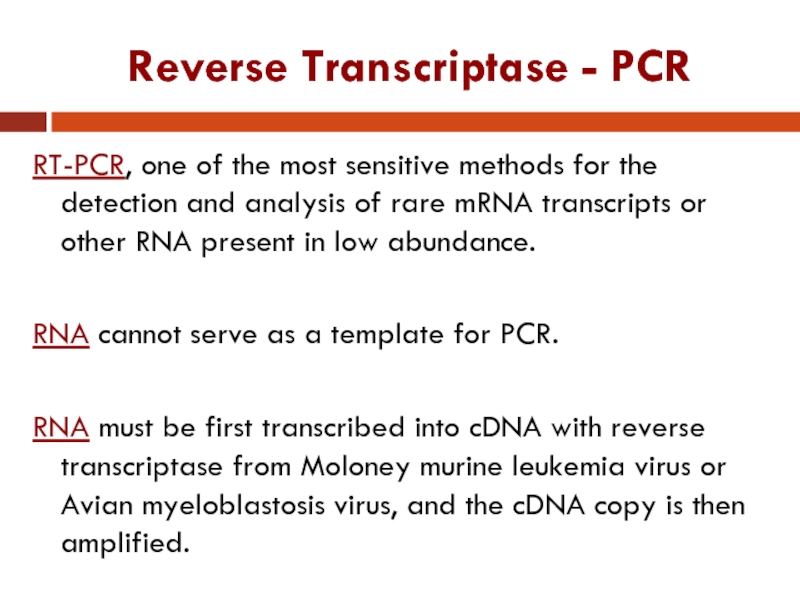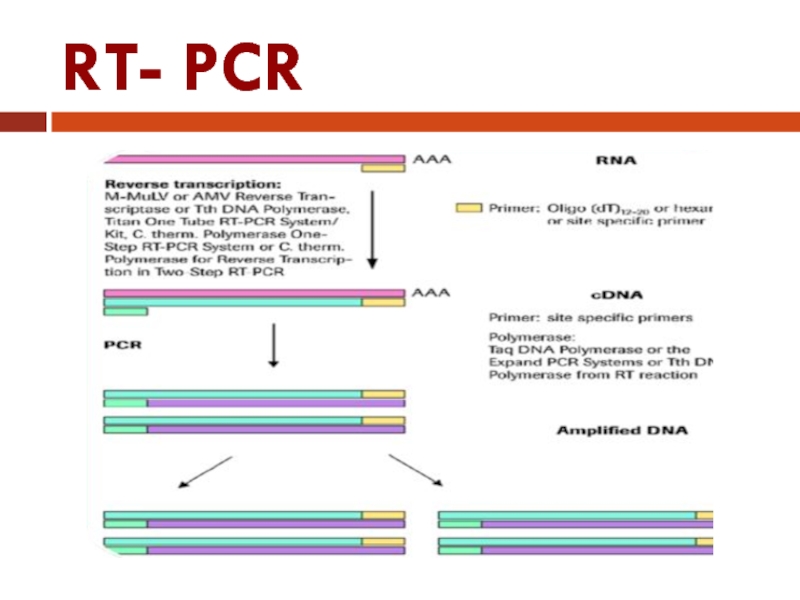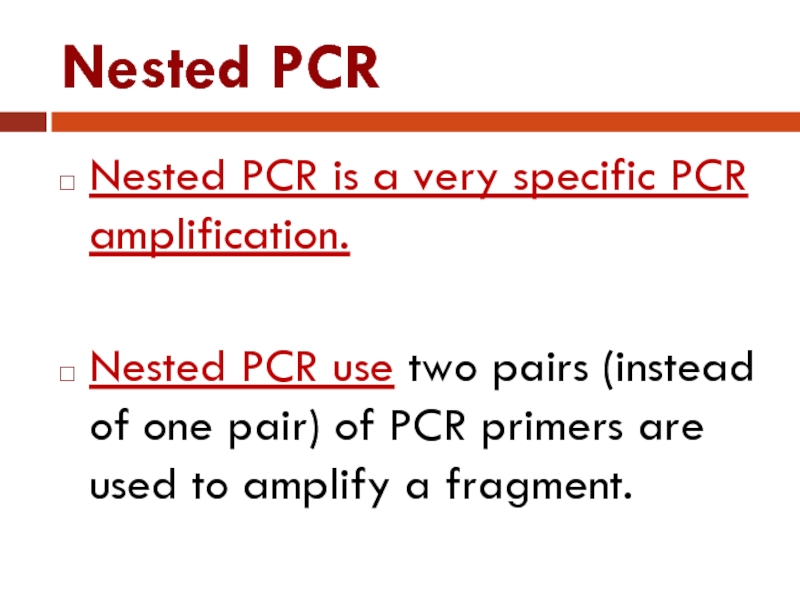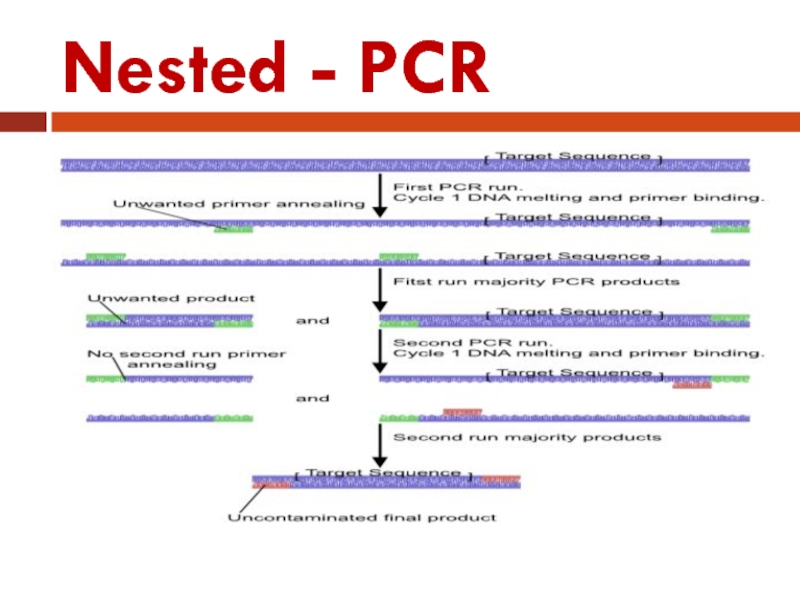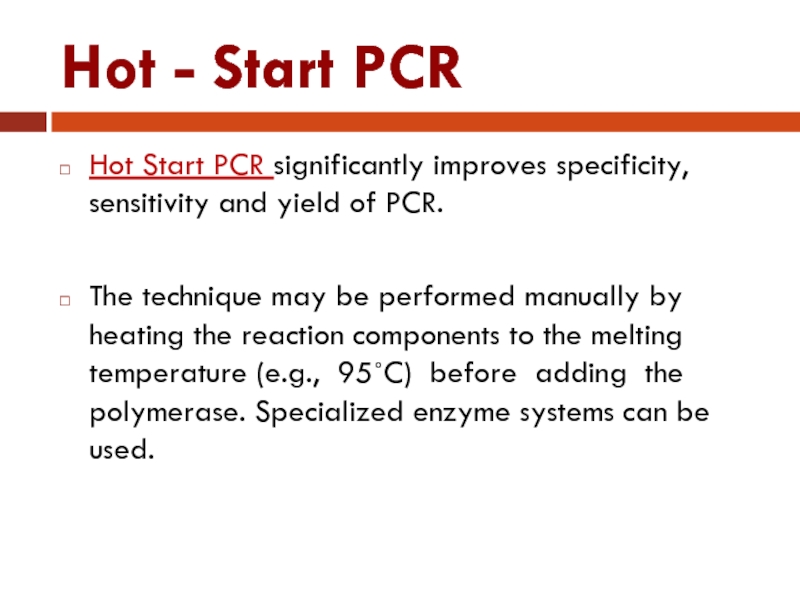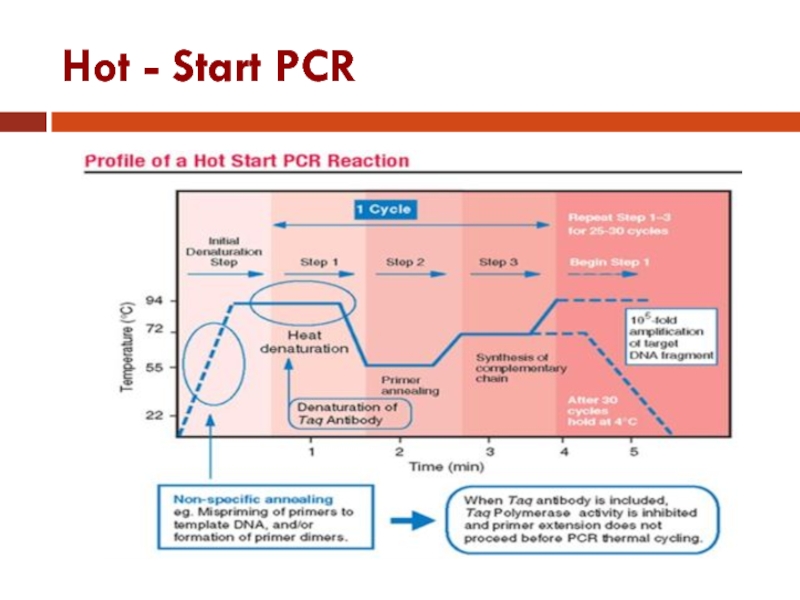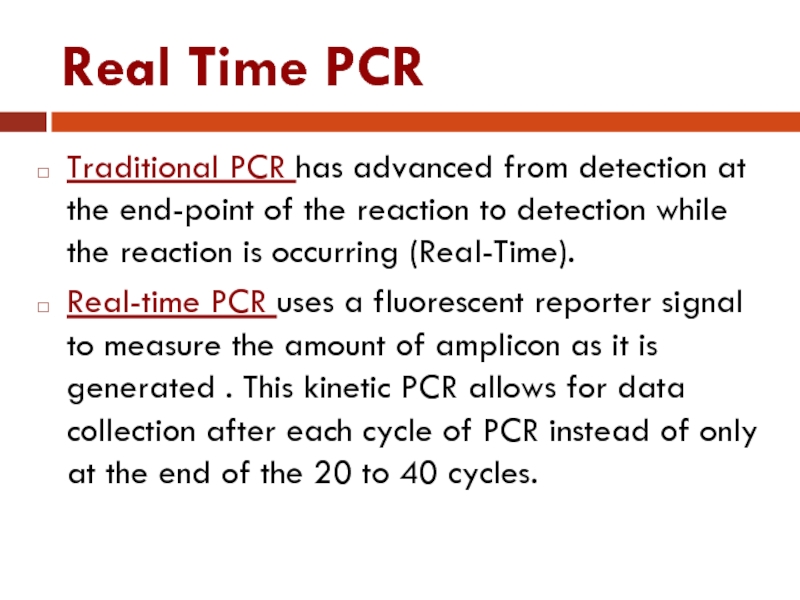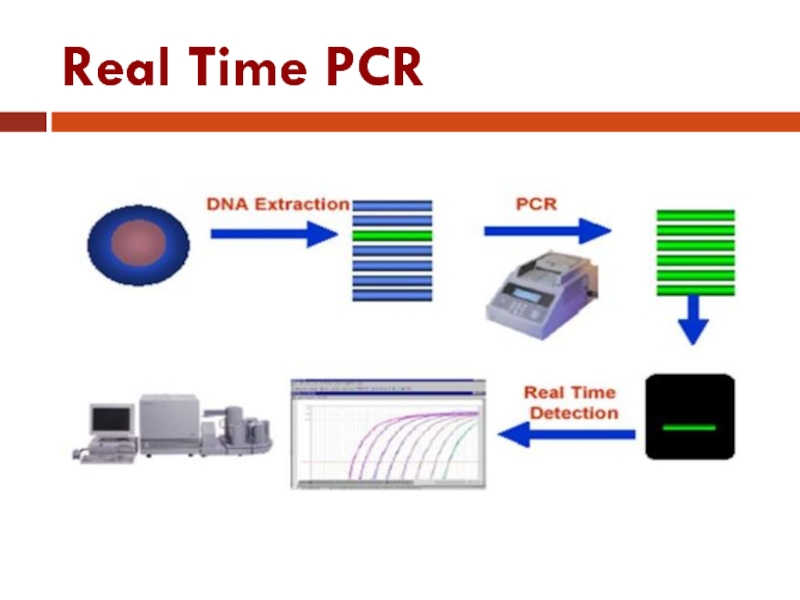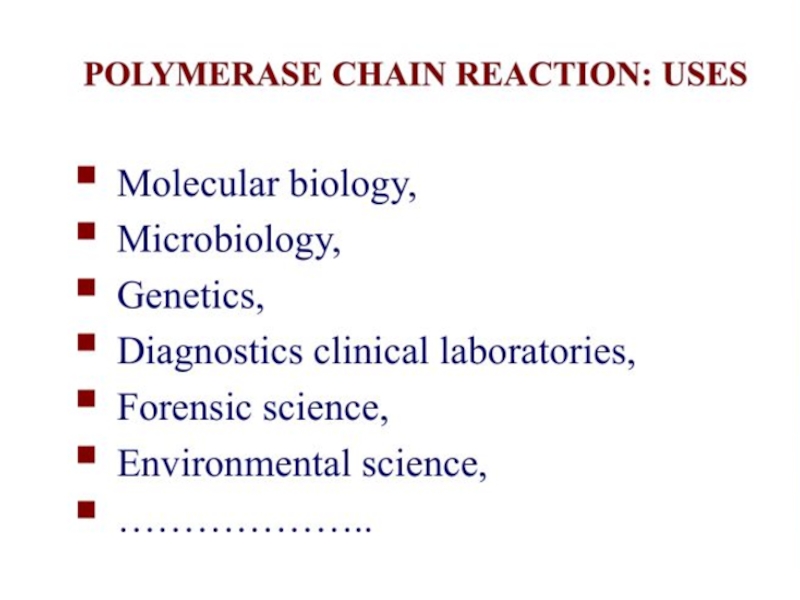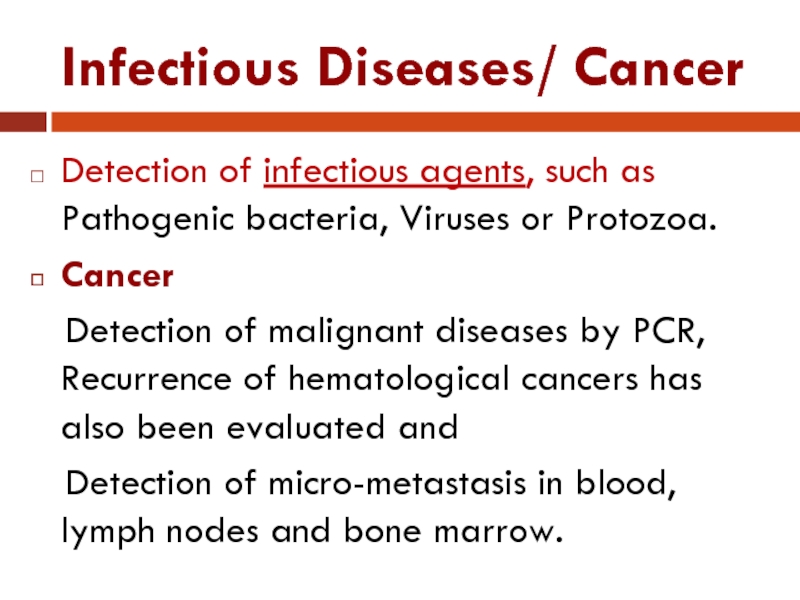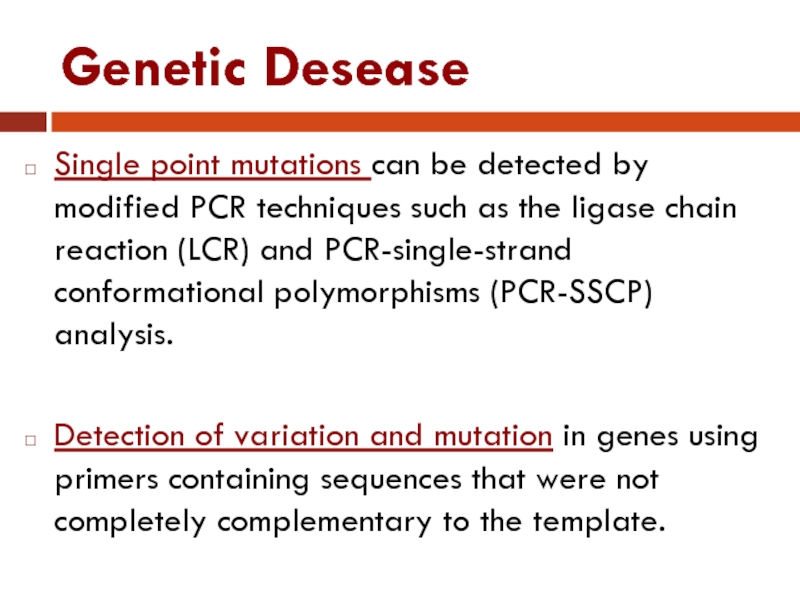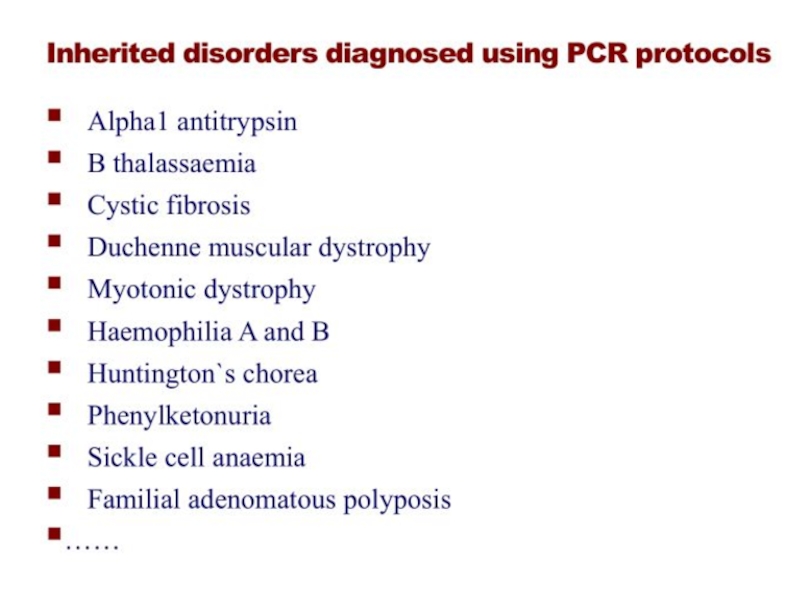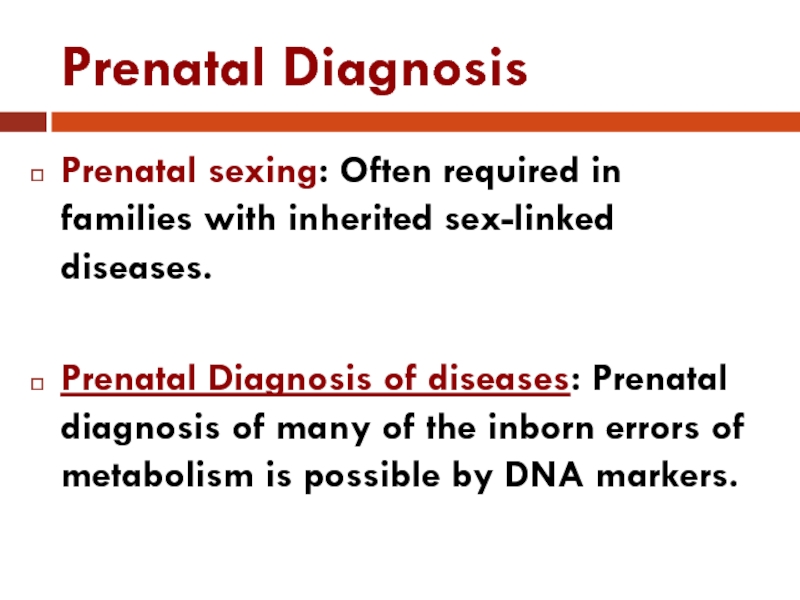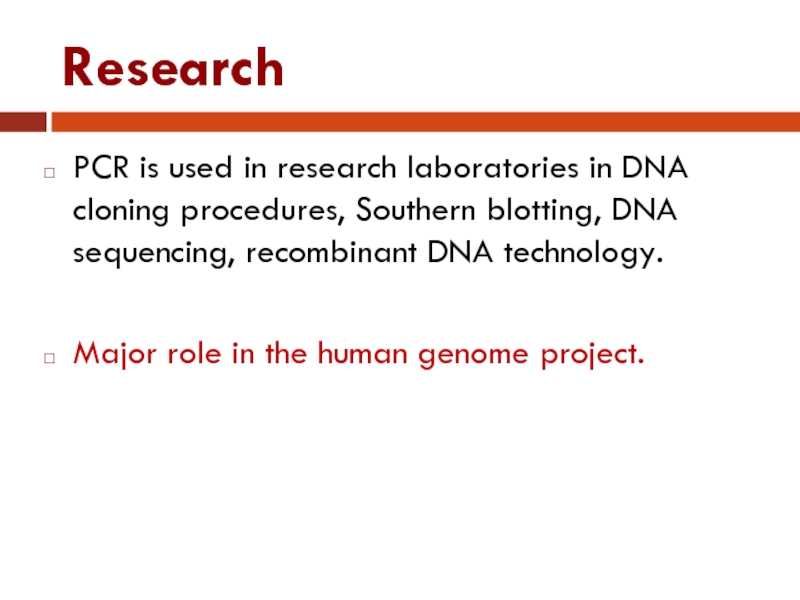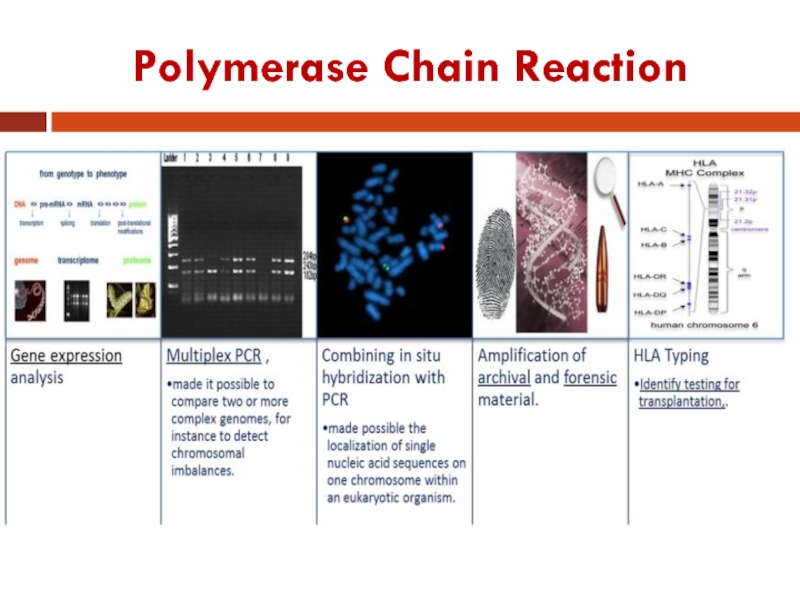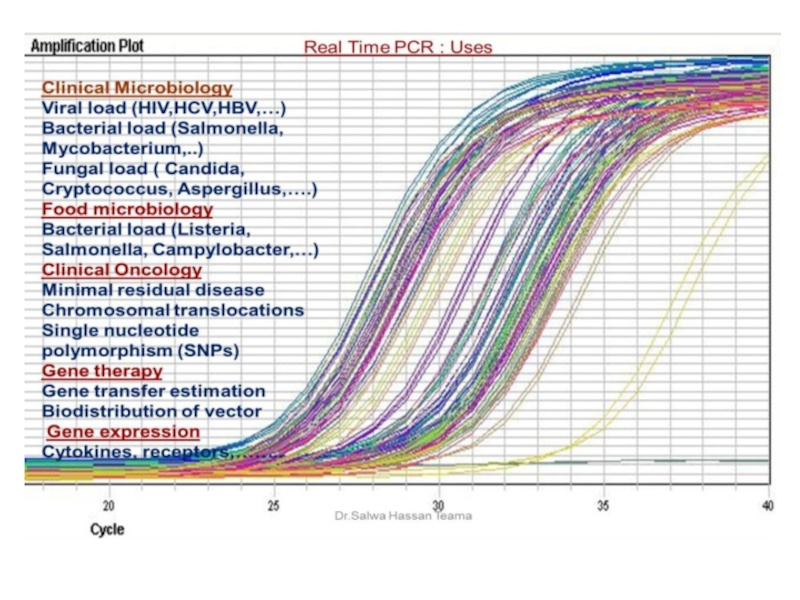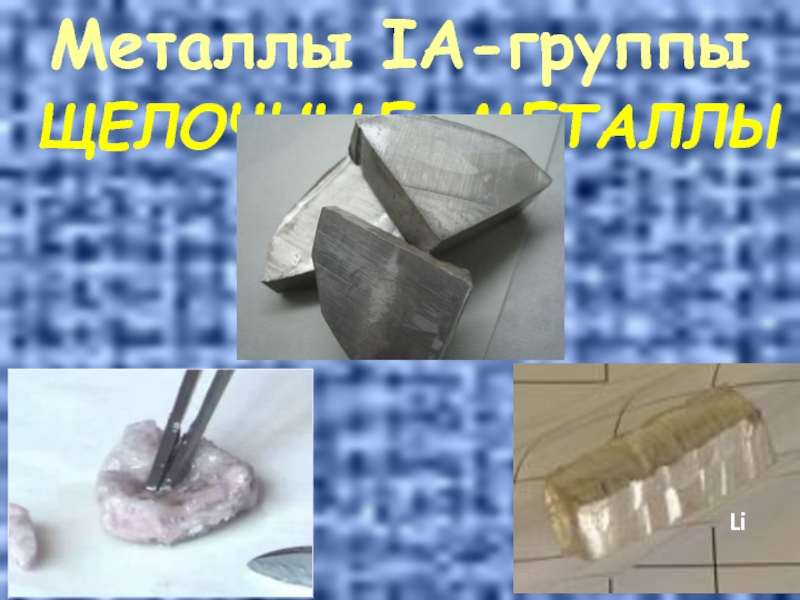- Главная
- Разное
- Дизайн
- Бизнес и предпринимательство
- Аналитика
- Образование
- Развлечения
- Красота и здоровье
- Финансы
- Государство
- Путешествия
- Спорт
- Недвижимость
- Армия
- Графика
- Культурология
- Еда и кулинария
- Лингвистика
- Английский язык
- Астрономия
- Алгебра
- Биология
- География
- Детские презентации
- Информатика
- История
- Литература
- Маркетинг
- Математика
- Медицина
- Менеджмент
- Музыка
- МХК
- Немецкий язык
- ОБЖ
- Обществознание
- Окружающий мир
- Педагогика
- Русский язык
- Технология
- Физика
- Философия
- Химия
- Шаблоны, картинки для презентаций
- Экология
- Экономика
- Юриспруденция
Polymerase chain reaction презентация
Содержание
- 1. Polymerase chain reaction
- 2. POLYMERASE CHAIN REACTION
- 3. Contents Polymerase Chain Reaction PCR Reaction Components
- 5. Coping Machine for DNA Molecule
- 6. Polymerase Chain Reaction PCR: Technique for in
- 7. PCR
- 8. PCR reaction components шаблон A, G, C, T Mg2+ (forward and reverse)
- 9. PCR reaction components DNA template Two primers
- 10. DNA Template Integrity High molecular weight Purity
- 11. Primers Typical primers are 18-28 bases in
- 12. Four Normal Deoxynucleosides Triphosphate Final concentration of
- 13. Tris-HCl 10mM (10-50mM) for
- 14. DNA Polymerase The most widely characterized polymerase
- 15. Enhance The Specificity and or Efficiency of
- 16. Calculation of Melting Temperature Tm= 2 C°
- 17. STANDARD PCR REACTION
- 18. PCR
- 19. AVOIDING CONTAMINATION
- 20. Sample Handling Use sterile techniques and always
- 21. Laboratory Facilities Set up physically separated working
- 22. Working with RNA Do not touch
- 23. Polymerase Chain Reaction
- 25. Thermal Cycling Profile for Standard PCR
- 26. Each cycle includes three successive steps:
- 27. PCR
- 28. Exponential Amplification As amplification proceeds, the DNA
- 29. Number of Cycles The number of cycles
- 30. GEL ELECTROPHORESIS
- 31. Agarose Gel Electrophoresis It is a method
- 32. Gel Tray/ Loading
- 33. PCR Product DNA Molecular Marker Amplified
- 34. » Factors, affect the mobility of molecules
- 35. PCR: Three Phases Exponential: Exact doubling of
- 36. PCR Phases
- 37. Polymerase Chain Reaction Advantages of PCR Useful
- 38. Variant PCR Reverse transcriptase-PCR. Nested-PCR. Hot-start PCR.
- 39. Reverse Transcriptase - PCR RT-PCR, one of
- 40. RT- PCR
- 41. Nested PCR Nested PCR is a very
- 42. Nested - PCR
- 43. Hot - Start PCR Hot Start PCR
- 44. Hot - Start PCR
- 45. Real Time PCR Traditional PCR has advanced
- 46. Real Time PCR
- 48. Infectious Diseases/ Cancer Detection of infectious agents,
- 49. Genetic Desease Single point mutations can be
- 51. Prenatal Diagnosis Prenatal sexing: Often required in
- 52. Research PCR is used in research laboratories
- 53. Polymerase Chain Reaction
Слайд 3Contents
Polymerase Chain Reaction
PCR Reaction Components
Standard PCR Reaction
Avoiding Contamination
Thermal Cycling Profile for
Standard PCR
Gel Electrophoresis
PCR: Three phases
Variants of PCR
Polymerase Chain Reaction: Uses
Gel Electrophoresis
PCR: Three phases
Variants of PCR
Polymerase Chain Reaction: Uses
Слайд 6Polymerase Chain Reaction
PCR: Technique for in vitro (test tube) amplification of
specific DNA sequences via the temperature mediated. DNA polymerase enzyme by simultaneous primer extension of complementary strands of DNA.
PCR: This system for DNA replication that allows a "target" DNA sequence to be selectively amplified, several million-fold in just a few hours.
PCR: This system for DNA replication that allows a "target" DNA sequence to be selectively amplified, several million-fold in just a few hours.
Слайд 9PCR reaction components
DNA template
Two primers
Four normal deoxynucleosides triphosphates
Buffer system
DNA polymerase I
Слайд 10DNA Template
Integrity
High molecular weight
Purity
Pure
Amount
Human genomic DNA should be up to 500ng
Bacterial
DNA 1-10ng
Plasmid DNA 0.1-1ng
Plasmid DNA 0.1-1ng
Слайд 11Primers
Typical primers are 18-28 bases in length,
Having 40- 60% GC composition,
Have
a balanced distribution of G/C and A/T rich domains,
The calculated Tm for a given primer pair should be balanced (difference no more than 5 °C),
Primer concentration between 0.1 and 0.6 µM are generally optimal,
Contain no internal secondary structure,
Have a cytosine and guanine at the 3'-end because they form three hydrogen bonds with the matrix molecules, making a more stable hybridization
The calculated Tm for a given primer pair should be balanced (difference no more than 5 °C),
Primer concentration between 0.1 and 0.6 µM are generally optimal,
Contain no internal secondary structure,
Have a cytosine and guanine at the 3'-end because they form three hydrogen bonds with the matrix molecules, making a more stable hybridization
Слайд 12Four Normal Deoxynucleosides Triphosphate
Final concentration of dNTPs should be 50-500 µM
(each dNTP). Usually included at conc. of 200 µM for each nucleotide.
Always use balanced solution of all four dNTPs to minimize polymerase error rate.
Always use balanced solution of all four dNTPs to minimize polymerase error rate.
Слайд 13 Tris-HCl 10mM (10-50mM) for dissolution of nucleic acids
рH 8.3 (рH 8.3-8.8 at 20C°)
KCl 50mM promotes specificity of hybridization
MgCL2 1.5mM (0.5-10mM) for stabilizing of complex between primers and matrix and for increasing of exit the special product of PCR
Gelatin or Bovine Serum Albumin 100 µg/ml
frequent unfreezing-freezing at the temperature -20C
The standard PCR buffer contains:
Buffer System Containing Magnesium
Слайд 14DNA Polymerase
The most widely characterized polymerase is that from Thermus aquaticus
(Taq), Thermophilic bacterium lives in hot springs and capable of growing at 70 -75 C°,
Consist of a single polypeptide chain has a molecular weight of 95 Kd, and has an optimum polymerization temperature of 70 – 80 C° (72 C°).
0.5 – 2 units/50µl reaction. Too little will limit the amount of products, while too much can produce unwanted non specific products.
Consist of a single polypeptide chain has a molecular weight of 95 Kd, and has an optimum polymerization temperature of 70 – 80 C° (72 C°).
0.5 – 2 units/50µl reaction. Too little will limit the amount of products, while too much can produce unwanted non specific products.
Слайд 15Enhance The Specificity and or Efficiency of a PCR
Betadine
(antiseptic)
Bovine serum albumin (for stabilizing of enzymes)
Dimethylysulfoxide for inhibition of connubium of initial
molecules of DNA
Glycerol
Pyrophosphate
Spermidine, Detergent, Gelatin,….
Bovine serum albumin (for stabilizing of enzymes)
Dimethylysulfoxide for inhibition of connubium of initial
molecules of DNA
Glycerol
Pyrophosphate
Spermidine, Detergent, Gelatin,….
Слайд 16Calculation of Melting Temperature
Tm= 2 C° X (number of A and
T bases)+4 C°X
(number of G and C bases).
(number of G and C bases).
Optimal annealing temperature are 5-10 C ° lower than Tm values of the primers .
Слайд 20Sample Handling
Use sterile techniques and always wear fresh gloves,
Always use new
or sterilized glassware, plasticware and pipettes to prepare the PCR reagents and template DNA,
Autoclave and sterilize all reagents and solution,
Have your own set of PCR reagent and Solution (store in small aliquots),
Positive and negative control should be included.
Autoclave and sterilize all reagents and solution,
Have your own set of PCR reagent and Solution (store in small aliquots),
Positive and negative control should be included.
Слайд 21Laboratory Facilities
Set up physically separated working places for:
Template preparation
Setting up PCR
reactions
Post PCR analysis
Use PCR only pipettes, micro-centrifuges and disposable gloves
Use aerosol resistant pipette tips
PCR reaction under a fume hood equipped with UV
LIGHT.
Post PCR analysis
Use PCR only pipettes, micro-centrifuges and disposable gloves
Use aerosol resistant pipette tips
PCR reaction under a fume hood equipped with UV
LIGHT.
Слайд 22Working with RNA
Do not touch a surface after putting the
gloves to avoid reintroduction of RNAse to decontaminated material.
Designate a special area for RNA work only.
Treat surface or benches and glassware with commercially available RNAse inactivating agents.
Designate a special area for RNA work only.
Treat surface or benches and glassware with commercially available RNAse inactivating agents.
Слайд 25Thermal Cycling Profile for Standard PCR
Initial Denaturation:
Initial heating
of the PCR mixture at 94- 95C within 2 min. is enough to completely denature complex genomic DNA.
Each cycle includes three successive steps: Denaturation, annealing and extension.
Post extension and holding:
Cycling should conclude with a final extension at 72 C° for 5 -15 minute to promote completion of partial extension products and then holding at 4 C°.
Each cycle includes three successive steps: Denaturation, annealing and extension.
Post extension and holding:
Cycling should conclude with a final extension at 72 C° for 5 -15 minute to promote completion of partial extension products and then holding at 4 C°.
Слайд 28Exponential Amplification
As amplification proceeds, the DNA sequence between primers doubles after
each cycle.
(The amplification of the target sequence proceeding in an exponential fashion ( 1 2 4 8 16…………….) up to million of times the starting amount until enough is present to be seen by gel electrophoresis.
(The amplification of the target sequence proceeding in an exponential fashion ( 1 2 4 8 16…………….) up to million of times the starting amount until enough is present to be seen by gel electrophoresis.
Слайд 29Number of Cycles
The number of cycles required for optimum amplification varies
depending on the amount of the starting material.
Most PCR should, therefore, include only 25 – 35 cycles. As cycle increases, nonspecific products can accumulate.
After 20- 40 cycles of heating and cooling build up over a million copies of original DNA molecules.
Most PCR should, therefore, include only 25 – 35 cycles. As cycle increases, nonspecific products can accumulate.
After 20- 40 cycles of heating and cooling build up over a million copies of original DNA molecules.
Слайд 31Agarose Gel Electrophoresis
It is a method used in biochemistry and molecular
biology to separate DNA, or RNA molecules based upon charge, size and shape.
Agarose is a polysaccharide derivative of agar.
Agarose is a polysaccharide derivative of agar.
Слайд 33PCR Product
DNA Molecular Marker
Amplified fragments can be visualized easily following
staining with a chemical stain such as ethidium bromide.
The DNA fragments are separated by charge and the relative sizes of fragments are determined by comparing to a standard DNA lad
The DNA fragments are separated by charge and the relative sizes of fragments are determined by comparing to a standard DNA lad
Слайд 34» Factors, affect the mobility of molecules in gel
Charge
Size
Shape
Buffer conditions
Gel concentration
and
Voltage
Voltage
Слайд 35PCR: Three Phases
Exponential: Exact doubling of product is accumulating at every
cycle (assuming 100% reaction efficiency). The reaction is very specific and precise.
Linear: The reaction components are being consumed; the reaction is slowing, and products are starting to degrade.
Plateau: The reaction has stopped; no more products are being made and if left long enough; the PCR products will begin to degrade.
Linear: The reaction components are being consumed; the reaction is slowing, and products are starting to degrade.
Plateau: The reaction has stopped; no more products are being made and if left long enough; the PCR products will begin to degrade.
Слайд 37Polymerase Chain Reaction
Advantages of PCR
Useful non- invasive procedure.
Simplicity of the procedure.
Sensitivity
of the PCR
Disadvantages of PCR
False positive results (cross contamination).
False negative results
Disadvantages of PCR
False positive results (cross contamination).
False negative results
Слайд 38Variant PCR
Reverse transcriptase-PCR.
Nested-PCR.
Hot-start PCR.
Quantitative PCR.
Multiplex-PCR.
Mutagenesis by PCR.
Allele specific PCR.
…..
Слайд 39Reverse Transcriptase - PCR
RT-PCR, one of the most sensitive methods for
the detection and analysis of rare mRNA transcripts or other RNA present in low abundance.
RNA cannot serve as a template for PCR.
RNA must be first transcribed into cDNA with reverse transcriptase from Moloney murine leukemia virus or Avian myeloblastosis virus, and the cDNA copy is then amplified.
RNA cannot serve as a template for PCR.
RNA must be first transcribed into cDNA with reverse transcriptase from Moloney murine leukemia virus or Avian myeloblastosis virus, and the cDNA copy is then amplified.
Слайд 41Nested PCR
Nested PCR is a very specific PCR amplification.
Nested PCR use
two pairs (instead of one pair) of PCR primers are used to amplify a fragment.
Слайд 43Hot - Start PCR
Hot Start PCR significantly improves specificity, sensitivity and
yield of PCR.
The technique may be performed manually by heating the reaction components to the melting temperature (e.g., 95˚C) before adding the polymerase. Specialized enzyme systems can be used.
The technique may be performed manually by heating the reaction components to the melting temperature (e.g., 95˚C) before adding the polymerase. Specialized enzyme systems can be used.
Слайд 45Real Time PCR
Traditional PCR has advanced from detection at the end-point
of the reaction to detection while the reaction is occurring (Real-Time).
Real-time PCR uses a fluorescent reporter signal to measure the amount of amplicon as it is generated . This kinetic PCR allows for data collection after each cycle of PCR instead of only at the end of the 20 to 40 cycles.
Real-time PCR uses a fluorescent reporter signal to measure the amount of amplicon as it is generated . This kinetic PCR allows for data collection after each cycle of PCR instead of only at the end of the 20 to 40 cycles.
Слайд 48Infectious Diseases/ Cancer
Detection of infectious agents, such as Pathogenic bacteria, Viruses
or Protozoa.
Cancer
Detection of malignant diseases by PCR, Recurrence of hematological cancers has also been evaluated and
Detection of micro-metastasis in blood, lymph nodes and bone marrow.
Cancer
Detection of malignant diseases by PCR, Recurrence of hematological cancers has also been evaluated and
Detection of micro-metastasis in blood, lymph nodes and bone marrow.
Слайд 49Genetic Desease
Single point mutations can be detected by modified PCR techniques
such as the ligase chain reaction (LCR) and PCR-single-strand conformational polymorphisms (PCR-SSCP) analysis.
Detection of variation and mutation in genes using primers containing sequences that were not completely complementary to the template.
Detection of variation and mutation in genes using primers containing sequences that were not completely complementary to the template.
Слайд 51Prenatal Diagnosis
Prenatal sexing: Often required in families with inherited sex-linked diseases.
Prenatal
Diagnosis of diseases: Prenatal diagnosis of many of the inborn errors of metabolism is possible by DNA markers.
Слайд 52Research
PCR is used in research laboratories in DNA cloning procedures, Southern
blotting, DNA sequencing, recombinant DNA technology.
Major role in the human genome project.
Major role in the human genome project.
